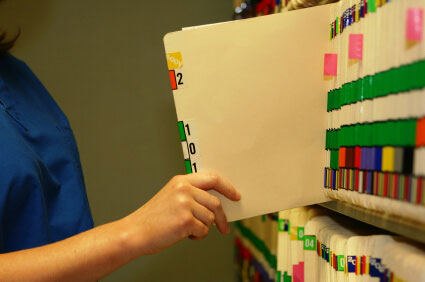Medical Record Scanning Project Preparation Guide

To efficiently manage a Medical Record Scanning Project, it’s helpful to understand what is involved in the process. A clear step-by-step overview will help clarify expectations and will save you lots of time and frustration later on.
Scanning medical records is not overly complicated, and with some careful planning, you can ensure that your practice runs more smoothly and efficiently than ever before. Also, if you’re inclined to outsource, selecting a company that works with you as a partner can result in greater satisfaction with the process and the end result.
The following are the steps to the medical document scanning process.
1. Analyze – First, identify what documents are to be scanned. Medical Files can be boxed and labeled, so they are able to be transported. It’s important to have a system to be sure you know what’s in the boxes, just in case there is a need for one of the documents during this process. A qualified vendor should work side by side with you when scanning medical records to ensure you have access to your charts. Be sure to confirm this during your vendor selection process.
2. Inventory – Prior to beginning a Medical Record Scanning Project, an inventory should be created highlighting all of the charts you want to convert. This can be something that your staff does or your vendor offers. Don’t overlook this step – You will want to be absolutely sure that you’ve captured all of your Charts, and this is the best way to give you confidence in the process.
3. Preparation – Imagine the havoc that staples and ripped or torn documents can do to a copier… well, they don’t work well with scanners either. Before scanning medical documents, any torn pages must be repaired, sorted, and staples, clips, fasteners, etc. must be removed. This is time-consuming, and most companies who take on scanning medical documents instead of outsourcing become frustrated at this point. Remember, clean, clear, useful document scans are entirely dependent upon this step.
4. Scanning – Each medical document is scanned. During this phase, the identification of the documents is entered. Again, somewhat labor intensive, this phase requires attention to detail that many companies just don’t put in. If you are scanning medical records yourself and hiring temporary workers, you may wind up with less than professional results. Especially for scanning medical records and documents, this is important. (Shoreline’s team are experts at ensuring efficient and competent production at our service center. See why choose Shoreline)
5. Quality Control – The last thing that you want is to pull up a patient’s record at a critical moment, and the information is indecipherable. A good quality control to evaluate every image will ensure this doesn’t happen. Missing documents and missing images are unacceptable. (At Shoreline, every image is reviewed to be sure it can be read. We also make sure we didn’t miss any documents or images during the scanning process.)
6. Index – Indexing documents is another critical element of scanning medical documents. In order to be found easily, the index utilizes an identifier such as the patient’s DOB, patient ID, social, or patient number. As records are scanned, charts are captured and tagged in a manner consistent with the EMR or EHR program.
7. Import Data – The scanned medical records that have been indexed are entered into the electronic records system. The vendor should work with your records management vendor to ensure that the documents are successfully accessed upon demand. Imaged information is integrated into the EMR or EHR system.
8. Disposition or Inventory – From time to time, records must be destroyed or re-called to be accessed physically. A document solution provider should be capable of providing a secure system for both. Whether the document is to be stored in a climate-controlled environment within a warehouse or be destroyed, the security of the information is of paramount importance, particularly with HIPAA requirements for medical records. (At Shoreline, Certified Document Destruction is offered for sensitive information.)
